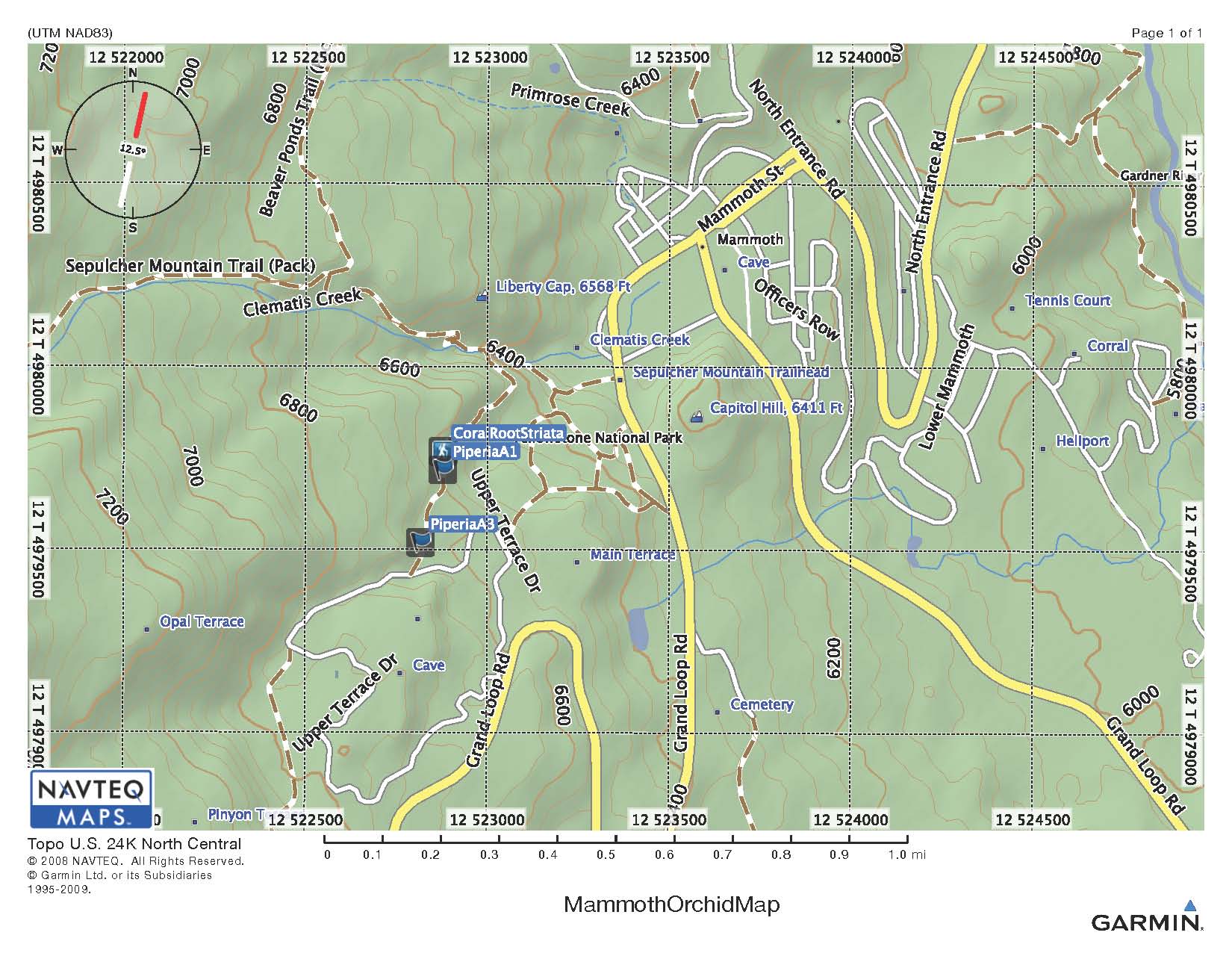There
are reported to be 15 species of orchids native to Yellowstone
National Park. I have found at least 10 of them. I hope this website
helps you learn to appreciate wild orchids in their native habitats.
Never try to transplant a native orchid. Many species require
certain soil characteristics, so you'll probably just destroy the
plant you are trying to love. Some are take nutrients from certain
fungi and bacteria in the soil, and this makes it virtually
impossible to grow them at home.
Location
List with maps and GPS coordinates:
These
are the locations where I have personally
found these orchids. These orchids undoubtedly grow in other areas
of the park with suitable habitat. The list below included locations
mainly close to roads or popular trails and boardwalks near
developed areas of Yellowstone. The detailed species pages above
describe the habitats a little more. I am listing the GPS locations
(in UTM coordinates) because many are available in the Herbarium
websites listed here. Perhaps more publicity of the locations will
yield better orchid
conservation.
Don't
pick or dig! It
is illegal to remove plants or artifacts from Yellowstone. There
is a double curse on those who steal orchids -- the orchids are lost
from the wild and they die after you transplant them because your
soil won't have the right fungi and nutrients.
Mammoth
Find Corallorhiza striata (striped coral root) and Piperia
unalascensis (Alaska rein orchid). A source in the 1890s called
the Alaska orchid "rare", and found them in Mammoth. There is a
nice colony of Alaska orchid between the markers on the map. Hike
the Narrow Gauge Trail that starts between the Liberty Cap and the
old building south of the restrooms. This is also the start of the
Beaver Ponds trail, but to go left onto the Narrow Gauge Trail
just before the second footbridge over Clematis Creek. After
climbing a bit you come to an area of Douglas Fir trees, and the
orchids are there. This is also a great trail to the upper hot
spring terrace.
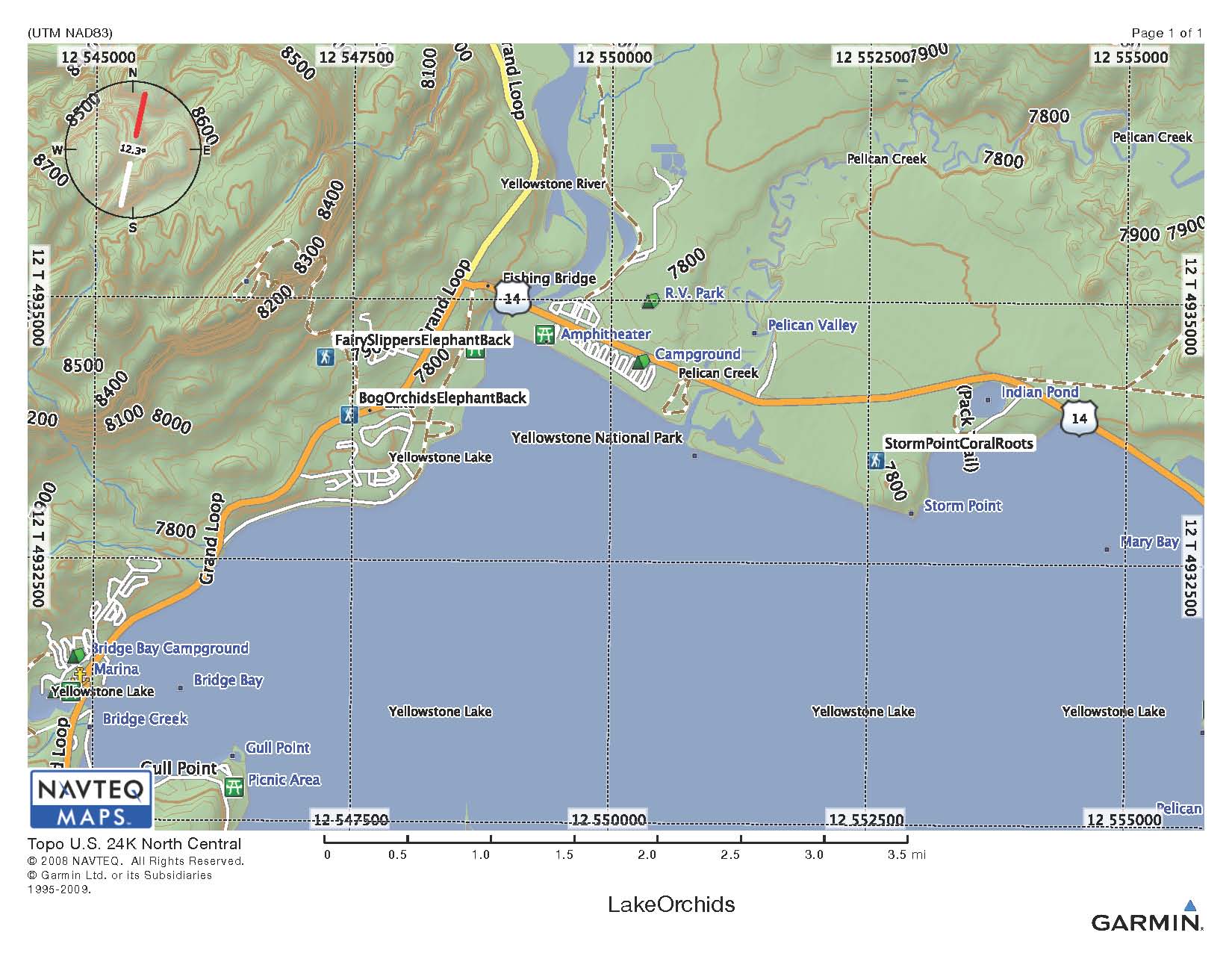 Lake
/
Fishing Bridge area Find Calypso bulbosa (fairy slipper),
Corallorhiza mertensiana (western coral root), Corallorhiza maculata
(spotted coral root), and Platanthera dilatata (white bog orchid).
This is a great area for orchids. The Calypso orchids are very close
to the Elephantback trail before you really start to climb
uphill. I found more to the left of the trail, but they did
exist on both sides. The white bog orchids are along the stream
between the Elephantback parking pullout and where the trail starts
into the woods. Coral roots are on the Storm Point Trail, which starts
east of Fishing Bridge. Also hike the Storm Point loop: after you you
reach the point you will cross some dunes, and then the trail enters
the woods to the north. The coral roots are to the sides of the trail
here, starting at about the same time ballhead waterleaf (Hydrophyllum
capitatum) is blooming. There are also western coral root orchids in
the woods at a pull out just east of Indian Pond.
Bridge Bay.
Just a couple of miles south of Fishing Bridge, there are white bog
orchids (Platanthera dilatata) along the Natural Bridge trail, as well
in some of the culverts in the meadows below the Bridge Bay
campground. Explore especially the culverts at the Grand Loop road
below Loop G of the campground. Natural Bridge trail is an old road
converted to a trail. It is an easy walk from the campground or from a
small pullout on the west side of Grand Loop road just south of the
bridge over Bridge Bay. Look for bog orchids in the ditch on the north
side of the road as well as around the small stream and meadow near
the natural bridge.
Lake
/
Fishing Bridge area Find Calypso bulbosa (fairy slipper),
Corallorhiza mertensiana (western coral root), Corallorhiza maculata
(spotted coral root), and Platanthera dilatata (white bog orchid).
This is a great area for orchids. The Calypso orchids are very close
to the Elephantback trail before you really start to climb
uphill. I found more to the left of the trail, but they did
exist on both sides. The white bog orchids are along the stream
between the Elephantback parking pullout and where the trail starts
into the woods. Coral roots are on the Storm Point Trail, which starts
east of Fishing Bridge. Also hike the Storm Point loop: after you you
reach the point you will cross some dunes, and then the trail enters
the woods to the north. The coral roots are to the sides of the trail
here, starting at about the same time ballhead waterleaf (Hydrophyllum
capitatum) is blooming. There are also western coral root orchids in
the woods at a pull out just east of Indian Pond.
Bridge Bay.
Just a couple of miles south of Fishing Bridge, there are white bog
orchids (Platanthera dilatata) along the Natural Bridge trail, as well
in some of the culverts in the meadows below the Bridge Bay
campground. Explore especially the culverts at the Grand Loop road
below Loop G of the campground. Natural Bridge trail is an old road
converted to a trail. It is an easy walk from the campground or from a
small pullout on the west side of Grand Loop road just south of the
bridge over Bridge Bay. Look for bog orchids in the ditch on the north
side of the road as well as around the small stream and meadow near
the natural bridge.
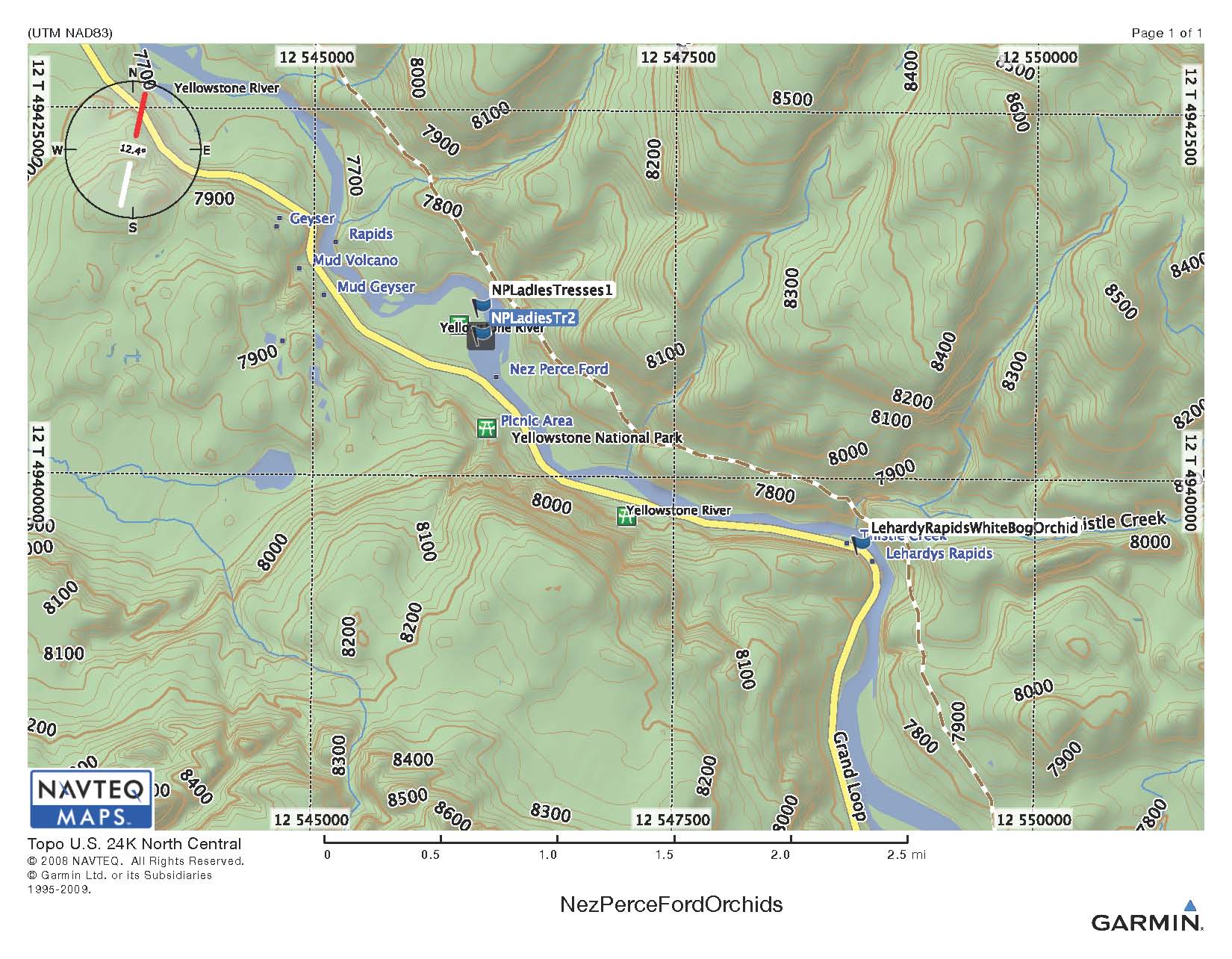 Nez
Perce Ford and LeHardy Rapids
A few miles north of Fishing Bridge, LeHardy
Rapids is the geological outlet of Lake Yellowstone. The
rapids once had large runs of native cutthroat trout on their way to
Lake Yellowstone. Sadly, the visitor is now unlikely to see fish
jumping. But you will probably see an osprey or eagle overhead, and
maybe a white pelican on a rock, indicators that there are still fish.
The Park Service has been re-vegetating trampled areas. There are now
bog orchids in the wet areas, growing near monk's hood (Aconitum
columbianum) and stinging nettle (Urtica dioica). Also look for Ladies
tresses (Spiranthes romanzoffiana) in the grass along the shore
downstream between late July and September (I haven't found the Ladies
Tresses here yet).
Nez Perce Ford, just south of the Mud Volcano area, is a
historical Native American crossing point on the Yellowstone River. It
is now a picnic area. The shoreline has a large colony of Ladies
Tresses orchids (Spiranthes romanzoffiana). Follow the informal
pathways from the large parking area down toward the Yellowstone
River, and look in the grass. These orchids are about the same height
as the grass they grow in. Take a whiff -- their aroma is great.
Nez
Perce Ford and LeHardy Rapids
A few miles north of Fishing Bridge, LeHardy
Rapids is the geological outlet of Lake Yellowstone. The
rapids once had large runs of native cutthroat trout on their way to
Lake Yellowstone. Sadly, the visitor is now unlikely to see fish
jumping. But you will probably see an osprey or eagle overhead, and
maybe a white pelican on a rock, indicators that there are still fish.
The Park Service has been re-vegetating trampled areas. There are now
bog orchids in the wet areas, growing near monk's hood (Aconitum
columbianum) and stinging nettle (Urtica dioica). Also look for Ladies
tresses (Spiranthes romanzoffiana) in the grass along the shore
downstream between late July and September (I haven't found the Ladies
Tresses here yet).
Nez Perce Ford, just south of the Mud Volcano area, is a
historical Native American crossing point on the Yellowstone River. It
is now a picnic area. The shoreline has a large colony of Ladies
Tresses orchids (Spiranthes romanzoffiana). Follow the informal
pathways from the large parking area down toward the Yellowstone
River, and look in the grass. These orchids are about the same height
as the grass they grow in. Take a whiff -- their aroma is great.
Corallorhiza
mertensiana (Western coralroot)
 Corallorhiza striata (Striped
coralroot)
Corallorhiza striata (Striped
coralroot)
 Corallorhiza trifida
(Early coralroot or Pale coralroot)
Corallorhiza trifida
(Early coralroot or Pale coralroot)
Goodyera oblongifolia
("Rattlesnake plantain orchid")
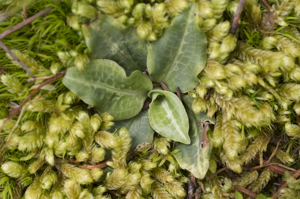 Goodyera oblongifolia (Rattlesnake plantain orchid)
Goodyera oblongifolia (Rattlesnake plantain orchid)
 Piperia unalascensis (Alaska rein orchid, or
Alaska orchid, also )
Piperia unalascensis (Alaska rein orchid, or
Alaska orchid, also )
Platanthera
(Bog orchids)
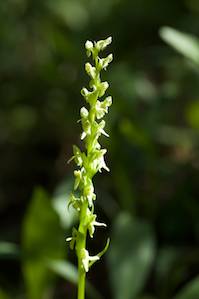 Platanthera dilatata (Tall white bog orchid, White rein orchid)
Platanthera dilatata (Tall white bog orchid, White rein orchid)
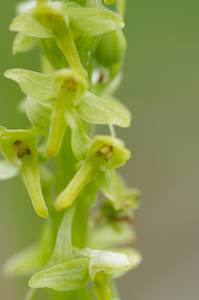 Platanthera aquilonis (Green bog orchid, see Platanthera page for
comments on Platanthera aquilonis)
Platanthera aquilonis (Green bog orchid, see Platanthera page for
comments on Platanthera aquilonis)
Location
list:
Apollinaris
Spring: Platanthera dilatata. (White bog orchids). Large colony here
in this historically interesting area that was once a main source of
fresh water for visitors coming from the North Entrance. Look in the
wet area above and to the left of the rock wall where the spring seeps
out. UTM 12 T 521088 4965518.
Artist's
paintpots: Piperia unalascensis (Alaska rein orchid). Look near the
boardwalks in the shade on slopes not real close to the thermals.
Biscuit
basin / Mystic Falls trail: Platanthera dilatata, Platanthera
huronensis (bog orchids). Near the falls and along the sides of the
trail at almost every wet seep. Also coral root (Corallorhiza sp.)
orchids. UTM: Platanthera dilatata 12T 0510615 4925726, Platanthera
huronensis 12T 0510844 4925767, Corallorhiza sp. (unidentified
buds) 12T 0510811 4925747.
Bridge
Bay / Natural Bridge trail: Platanthera dilatata, Platanthera
huronensis (white and green bog orchids). Look in the ditch on the
uphill side of the trail. Also, near the culverts at the Grand Loop
road below the campground Loops G and H.
Canyon:
Corallorhiza mertensiana (Western coralroot). Beside the trail
from P-loop cabins to Grandview, near north rim parking lot. Also, on
the trail along the rim from Artist's Point. Goodyera oblongifolia
(rattlesnake plantain): Large colony not far from Artist's point on
trail along the south rim.
Gibbon
River: Platanthera sp. (bog orchids), Spiranthes romanzoffiana (Ladies
tresses). Use any fishing pullout between Gibbon Falls and Madison
Junction, look near the shore in the sun for Spiranthes, and look in
the shade for Platanthera species.
Ice
Lake trail: Bog orchids (Platanthera dilatata, and Platanthera
aquilonis), both white and green bog orchids, in the wet areas between
the trail and the lake.
Lamar
River: Platanthera dilatata, Platanthera huronensis (Bog
orchids). Along Warm Creek near the picnic area, follow trails toward
creek, orchids are slightly back from shore in 'weedy' areas (yes, I
mean non-native weeds).
LeHardy
Rapids: Platanthera dilatata (Bog orchids). Look on the uphill side of
boardwalk near a seep.
Mammoth
area: Corallorhiza striata (Striped coral root), Piperia unalascensis
(Alaska rein orchid). In the woods on Beaver Ponds trail along
Clematis Creek, and in the woods along Narrow Gauge trail before you
reach the thermals.
Midway
geyser basin / Fairy falls trail: Platanthera dilatata,
Platanthera huronensis (Bog orchids). Look around the seeps and small
stream crossings between the Old Freight Road and Fairy Falls.
Nez
Perce Ford Picnic Area: Spiranthes romanzoffiana (Ladies tresses),
large colony by Yellowstone River in grass between picnic parking lot
and river. This colony extends in both directions.
Nez
Perce Creek and Fountain Flat: Spiranthes romanzoffiana (Ladies
tresses) by the creek, either on the east side of Grand Loop road near
a small pullout, or near the picnic area on the west side of the Grand
Loop road.
Norris:
Spiranthes romanzoffiana (Ladies tresses). I found at least two
blossoms near the boardwalk past Steamboat geyser (in the Back basin).
Corallorhiza (coralroot orchids) on the trail from the campground to
the geyser basin, and in the Norris picnic area.
Old
Faithful area: This is a rewarding area for orchids. Corallorhiza
mertensiana (Western coralroot), Platanthera dilatata (Bog
orchid), Platanthera huronensis (Bog orchid), Spiranthes romanzoffiana
(Ladies tresses). From the footbridge over the Firehole River closest
to the Old Faithful Lodge, look down into the grasses near the shore
to see the bog orchids and the ladies tresses. The western coralroots
are in a large colony between the cabins and the Firehole River
(follow the old sewer line from the cabins into the employee cabin
area, then look in the woods near a large boulder). There are also
large numbers of western coralroots in the picnic area at the back of
the Old Faithful parking area.
Lone
Star Geyser Trail: Corallorhiza mertensiana (Western
coralroot), Platanthera dilatata (white bog orchid), Platanthera
huronensis (green bog orchid), and Goodyera oblongifolia. This is an
easy trail with little elevation change to the geyser. Look under
lodgepole pine near the start of the trail for western coralroots,
look in the wet areas for bog orchids, and look for Goodyera
oblongifolia under fir trees and near pipsissewa.
Roosevelt
Lodge /Lost Lake and Lost Falls trails: Calypso bulbosa
(Fairy Slipper), Corallorhiza trifida (Early pale coralroot).
Look for the Calypso bulbosa (fairy slippers) are in really huge
colonies along the Lost Lake trail as it switchbacks up from
Roosevelt. Pay attention to whether they have a mostly white lip or
mostly pink lip -- these are two separate varieties. Look for the
early coralroot under other vegetation on the Lost Creek Falls trail
as well as near the fairy slippers on the Lost Lake trail in deep
moss. There are also some scattered Calypso bulbosa on the Lost Creek
Falls trail.
Trout
Lake trail (Lamar Valley between Pebble Creek Campground and Soda
Butte): Calypso bulbosa (Fairy Slipper). On the uphill side of
the trail around the lake, in a very shady spot.
Virginia
Cascades drive: Corallorhiza mertensiana (western coral root) very
close to the parking area of the first pullout. Bog orchids
(Platanthera dilatata, and Platanthera huronensis), both white and
green, on the opposite side upstream from the falls.
West
Thumb: Piperia unalascensis (Alaska rein orchids) in a small colony to
the left of the Overlook trail before it crosses the road.
Approximate
Blooming Dates: Blooming date depends on spring melt
timing, altitude, and location, but here are some guidelines. Look at
the dates on my photos also.
by species:
Calypso Bulbosa (Fairy slipper): mid-May to mid-June. Can find wilted
specimens later.
Corallorhiza trifida (Early pale coralroot):
mid-May to mid-June.
Corallorhiza mertensiana (Western
coralroot): early June to early July.
Corallorhiza maculata (Spotted coralroot): mid-June to mid-July
Corallorhiza striata (Striped coralroot): mid-May to mid-June
Piperia unalascensis (Alaska rein orchid): mid-June to mid-July.
Platanthera dilatata (White bog orchid): mid-June to late July
Platanthera huronensis (Green bog orchid): mid-June to late July
Spiranthes romanzoffiana (Hooded ladies tresses): mid-July to early
September
Goodyera oblongifolia (rattlesnake plantain orchid): mid-July to
early September
by
date:
Mid-May to mid-June: Calypso
bulbosa (Fairy Slipper), Corallorhiza trifida (Early
pale coralroot), Corallorhiza
striata (Striped coralroot)
mid-June to July: Platanthera dilatata (White bog orchid),
Platanthera huronensis (Green bog orchid), Corallorhiza mertensiana
(Western coralroot), Corallorhiza maculata (Spotted coralroot)
August to September: seedpods of all earlier orchids, Spiranthes
romanzoffiana (Hooded ladies tresses), Goodyera oblongifolia



